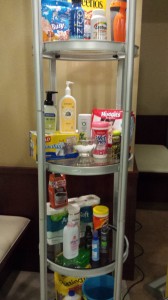Shell cracker plant shuffles forward, negotiating a regulatory roadmap

By Rachel Martin | Watchdog.org
PITTSBURGH — News earlier this month that Shell Chemicals would buy an industrial site in Beaver County is a major step in the company’s plans to bring thousands of jobs to western Pennsylvania.
The purchase is necessary for some of the many, many permits that will be required before the project becomes a reality.
PRETTY IN PLASTIC: Shell had a display of the wide variety of products that use the type of polyethylene pellets it hopes to produce in western Pennsylvania.
The planned facility is known as a “cracker plant” because it “cracks” ethane into smaller molecules. The facility would make a variety of plastic pellets that would then be shipped out to be made into a variety of plastic products.
After postponing the purchase three times, Shell finally decided Nov. 7 to exercise its option to purchase the Horsehead industrial site, which is over 300 acres.
According to materials from Shell, the site selection process typically can take up to four years, and it can take another four between breaking ground and plant operation.
“We have not made a final decision, but continue making progress,” said Barbara Blakely, who is part of the Shell leadership team for the project.
Blakely was part of a community meeting held by the company last week in Midland, Pa. It was one of several the company has held, and more are planned as the community continues to engage and submit questions and concerns.
If Shell goes through with the project, it would involve more than just construction on the site itself. The plans currently include widening Pennsylvania Route 18 to six lanes during construction, then reducing the road back to four lanes when construction is completed.
The plans also call for moving the road about 900 feet farther away from the Ohio River and upgrading the nearby interchange with Interstate 376
Randy Armstrong is a senior environmental adviser for Shell and a nearly 40-year veteran with the company. He said that one time when he counted up the permits needed for the project, he got to about 130. These span an array of agencies.

NIGHT LIGHTS: Shell provided this picture of a similar petrochemical plant, to show what the proposed facility might look like.
Panelist Denise Brinley said that the redevelopment of the industrial site is a positive feature. By using a “brownfield” site — often abandoned industrial sites — instead of unused “greenfield,” the land is essentially recycled.
And remediating the site is “pretty much a negotiation with the state,” said Armstrong. Another benefit of using an industrial site is that wildlife already have adapted to it, he said.
John Poister, spokesman for the southwestern region of the Pennsylvania Department of Environmental Protection, said that the company is moving “very slowly and deliberately.”
He said the company had so far applied for one air-quality permit, which is very detailed, and will have to apply for more.
When operational, the plant would employ around 400 workers, and up to 10,000 during “peak activity levels” of construction. At least one study also has found that the project could have a hand in bringing up to 20,000 jobs to the region.
Outgoing Gov. Tom Corbett was an ardent supporter of the project, advocating for a tax-break deal that ultimately could be worth $1.65 million over 25 years. That’s a state record.
Gov.-elect Tom Wolf has indicated his support for the project, as well. Even in his campaign materials, he cited it as one example of a “great opportunity to grow and transform Pennsylvania’s manufacturing economy” from the Marcellus Shale oil and gas production.

TRAVERSING THE TIMELINE: Materials from Shell show the general time frame for such projects.







